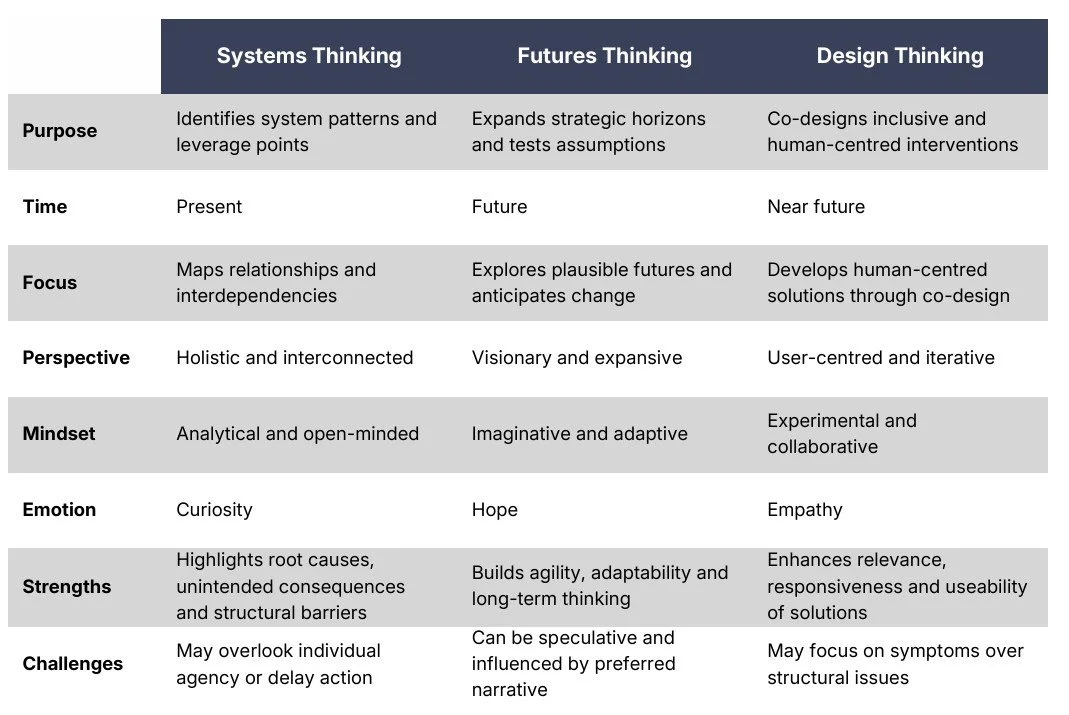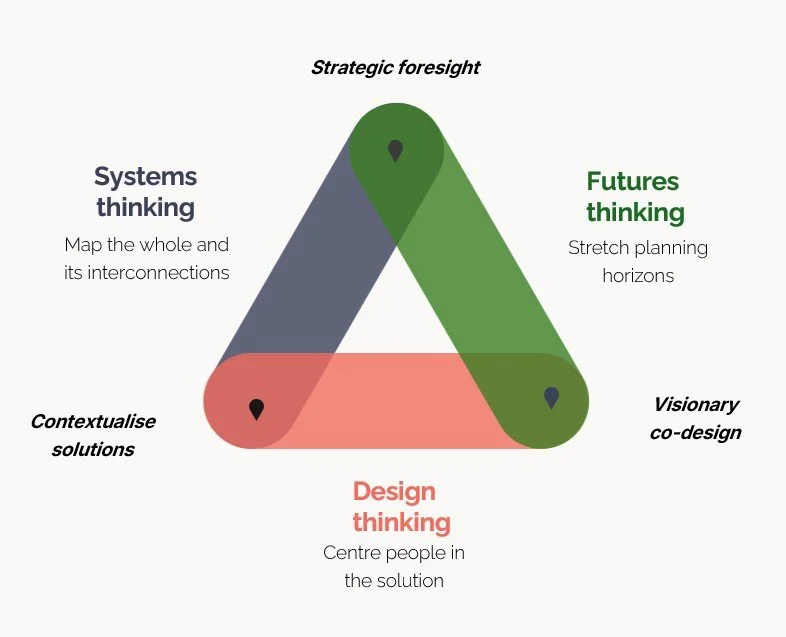Navigating public health challenges through integrated thinking
Public health professionals are increasingly called to think differently in response to complex challenges. While systems thinking has long shaped how we understand complexity in the profession, growing interest in design and futures thinking is signalling a broader strategic shift by helping us anticipate possibility and design human-centred solutions.
In this article, I compare these thinking approaches and look at how intentional integration can support and strengthen more adaptive, inclusive and sustainable solutions.
Three thinking approaches to navigate complexity
Systems Thinking
The whole is greater than the sum of all its parts. Systems thinking helps us see the whole through surfacing feedback loops, power dynamics and unintended consequences. It helps to reveal how health outcomes are shaped by social, economic and policy conditions. Essentially, systems thinking helps bring structure and insight to complexity.
Futures Thinking
We must imagine possibilities for a vision of the future we hope to create. Futures thinking encourages us to look beyond the now to explore emerging signals, anticipate possibilities and prepare for uncertainty. Rather than predicting the future, it supports readiness across shifting landscapes and ecosystems, helping stretch time horizons and build strategic agility. It helps us to think beyond immediate or crisis responses.
Design Thinking
Empathy is the core driver of innovation and solutions that reflect the needs of those we serve. Design thinking invites us to reframe problems through lived experience and co-design. It brings empathy and iteration into strategy and service design, helping shape solutions that are inclusive, responsive and driven by community need. This thinking lens ensures that we use a bottom-up approach where we place the user at the centre of the solution.
Different lenses, distinct strengths
In public health, strategic planning requires flexibility to respond to changing circumstances and diverse stakeholder perspectives. While these approaches share a commitment to learning and adaptation, they bring different strengths to the table. Systems thinking focuses on understanding structures and relationships. Futures thinking stretches our view forward to anticipate possibilities. Design thinking grounds solutions in lived experience and iterative testing.
The table below outlines how they diverge across key dimensions, highlighting the unique contribution each makes to tackling complexity.
Table 1: Characteristics of systems, futures and design thinking
Shared foundations in practice
Even though these approaches differ in focus and methods, they share important foundations. Each encourages adaptive learning, inclusive participation and reflexive practice. They are not interchangeable, but they often converge around similar values: recognising complexity, engaging diverse perspectives, and seeking solutions that evolve over time. Figure 1 illustrates this overlap as a triangle, with each point representing one of the approaches. Table 2 expands on these principles in more detail.
Figure 1: Intersection of systems, futures and design thinking
Table 2: Core principles across the three approaches
Intentional integration
Integration creates a more resilient foundation for public health strategy and one that balances understanding, imagination, empathy, learning and adaptation. This should be a strategic imperative for engaging with complexity and generating actionable insights for impact rather than methodological or mindset preference.
So what? When we combine systems, futures, and design thinking, we have the ability to understand current realities, anticipate emerging trends and co-design solutions that better meet the needs of communities and populations.
Now what? For practitioners, this means intentionally moving between these approaches rather than relying on one dominant lens that feels more comfortable. It’s about experimenting with integration rather than using all three for the sake of it. This is about using complementary tools to build strategies that bring about the change we envision within a learning culture and adaptive environment.
A working example:
Consider a regional planning body tasked with improving access to preventative health services in communities with rising rates of chronic disease. Traditional approaches draw on population health profiles, service utilisation data and standard needs assessments. While valuable, these methods often fail to produce substantial shifts in outcomes or reduce inequities because they rely on retrospective data and static assumptions.
An integrated approach changes the conversation:
Systems thinking maps the drivers of health outcomes and access e.g. workforce distribution, funding models and social determinants, revealing how they interact. Tools like causal loop diagrams or systems maps can help visualise feedback looks, for instance showing how limited access leads to delayed care which increases costs and puts services under further strain, increasing inequity.
Futures thinking stretches the time horizon, testing scenarios such as climate-driven migration, digital health uptake and alternative workforce models to challenge present-day assumptions. You might use tools to undertake horizon scanning beyond the traditional environmental scanning practice to identify emerging trends, or develop scenario planning exercises to explore how different futures could impact service needs and resource allocation.
Design thinking brings in community perspectives through empathy interviews and co-design workshops, uncovering barriers invisible in the data and prototyping solutions with stakeholders.Empathy interviews, journey mapping and co-design workshops can reveal barriers invisible in the data, such as cultural or logistical challenges to accessing care. Prototypes of service models can then be tested with users and stakeholders, allowing rapid feedback and iteration before wider implementation.
The result is a population health plan that combines systemic insight, anticipatory thinking and lived experience, producing strategies that are more responsive, equitable and adaptable to changing conditions.
Exploring new ways of thinking
In public health, systems, futures and design thinking are three approaches gaining traction for navigating complexity. They offer valuable and complementary ways to understand and act. The important step is to start considering these (and other) approaches as options and to reflect on why integrating multiple perspectives might matter in your work. Asking what these approaches bring individually and together opens space for new possibilities and more adaptive, inclusive strategies. This mindset of intentional exploration sets the stage for effective action, even before deciding exactly how to apply them.




